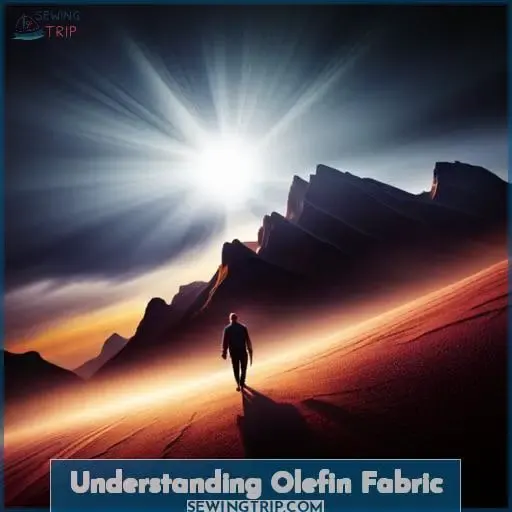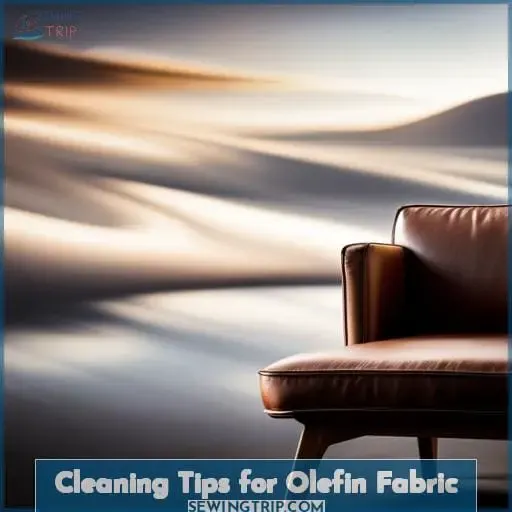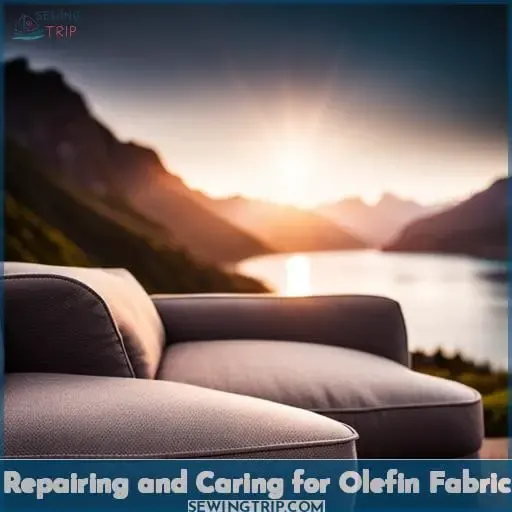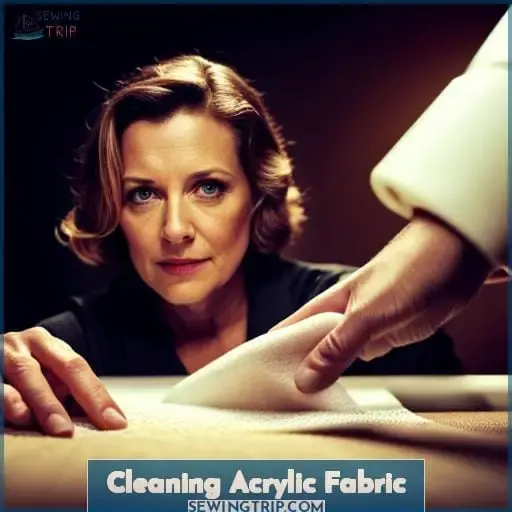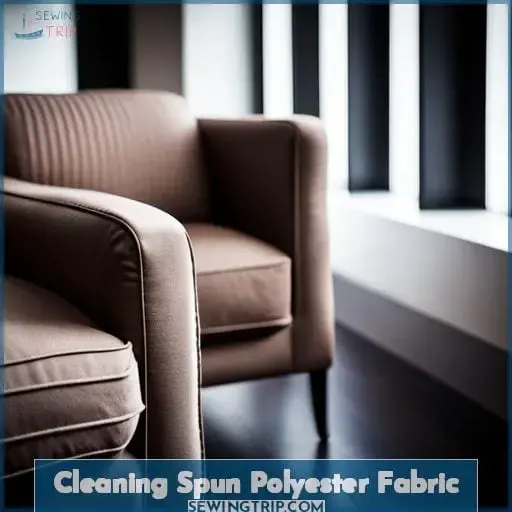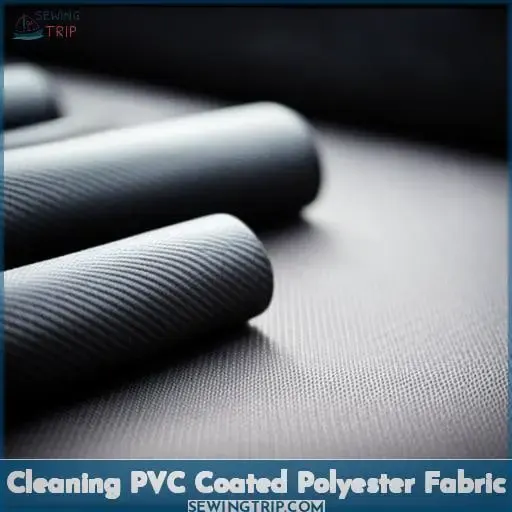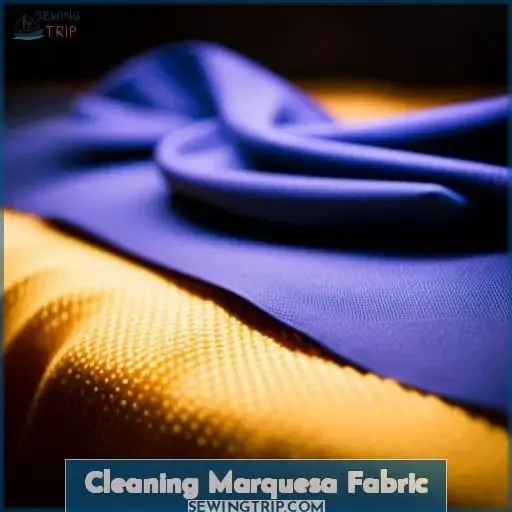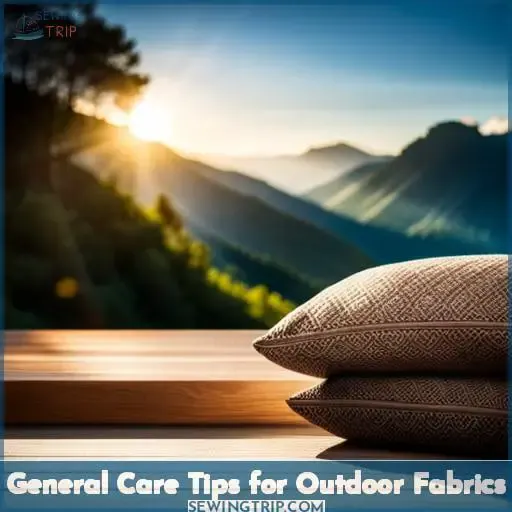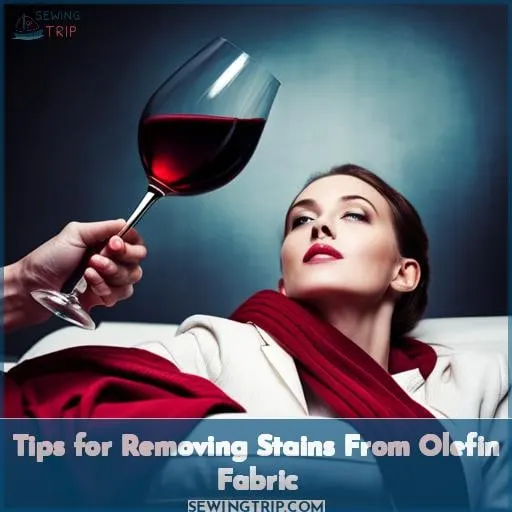This site is supported by our readers. We may earn a commission, at no cost to you, if you purchase through links.
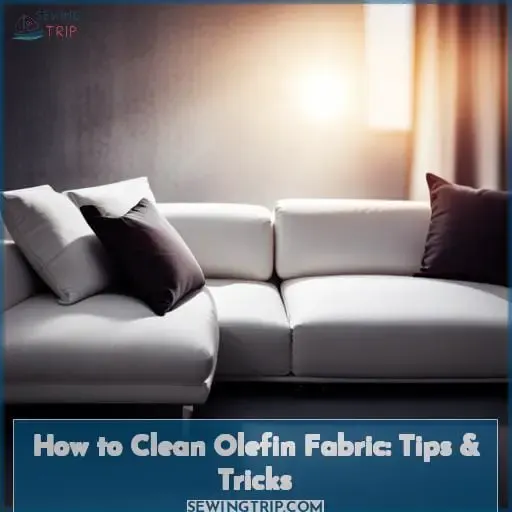 Are you wondering how to clean olefin fabric? Olefin, also known as polypropylene, is a synthetic fiber that offers many advantages when it comes to cleaning and care. It’s lightweight yet durable, highly resistant to stains and fading due in part to its high colorfastness rating.
Are you wondering how to clean olefin fabric? Olefin, also known as polypropylene, is a synthetic fiber that offers many advantages when it comes to cleaning and care. It’s lightweight yet durable, highly resistant to stains and fading due in part to its high colorfastness rating.
Plus, since it’s 100% recyclable, this eco-friendly fabric is great for the environment too! To ensure your olefin fabrics look their best throughout their lifetime, here are some tips on proper cleaning techniques – from treating tough stains through ironing methods all the way through storing them properly.
Read on for everything you need to know about keeping your olefin fabrics looking like new!
Table Of Contents
- Key Takeaways
- How to Clean Olefin Fabric
- Understanding Olefin Fabric
- Cleaning Tips for Olefin Fabric
- Repairing and Caring for Olefin Fabric
- Cleaning Acrylic Fabric
- Cleaning Spun Polyester Fabric
- Cleaning PVC Coated Polyester Fabric
- Cleaning Marquesa Fabric
- General Care Tips for Outdoor Fabrics
- Tips for Removing Stains From Olefin Fabric
- Conclusion
Key Takeaways
- Use mild detergent and lukewarm water for general washing when cleaning olefin fabric.
- Promptly treat oil-based stains with dish soap.
- After pre-treating stains, thoroughly rinse the fabric.
- When cleaning olefin, avoid using excessive heat.
How to Clean Olefin Fabric
Dear reader, cleaning olefin fabric properly is key to maintaining its durable and stain-resistant qualities. When caring for items made of this synthetic material, use a mild detergent and lukewarm water for general washing.
Avoid ironing and wash items after every few wearings to prevent buildup; pre-treating oil-based stains quickly is also advised since olefin is vulnerable to grease.
General Cleaning Instructions
You’ve got this! Just grab that stain-resistant olefin upholstery and show it who’s boss with some lukewarm soapy water. Gently scrub using a soft brush. Thoroughly rinse, then let air dry to avoid heat damage.
For freshness, store folded or on hangers in a cool, dry place and launder frequently.
Treating Stains on Olefin Fabric
Treating stains on olefin fabric calls for approaching each one individually, as oil-based products can be tricky while water-soluble spills are simpler. Use a detergent formulated for synthetics and spot-clean stains immediately to prevent setting them.
- Pre-treat the fabric with dish soap.
- Thoroughly rinse the fabric after pre-treating.
- Avoid using excessive heat when cleaning olefin fabric.
- Use oxygen bleach if needed to remove tough stains.
- For stubborn stains, repeat the cleaning process.
Thorough cleaning and immediate stain treatment help preserve the appearance of olefin fabric.
Ironing Olefin Fabric
Olefin fabrics should not be ironed, as the heat can damage the fibers. Instead, allow olefin fabrics to air dry after washing. To prevent wrinkles, fold and store the fabric flat. For olefin activewear, wash frequently using mild detergent.
Storing Olefin Fabric
Roll it up nicely before tucking it away to prevent wrinkles and damage.
- Use acid-free tissue paper.
- Store in breathable fabric bags.
- Keep in a cool, dry place.
- Refresh with steam or pressing before use.
As an olefin fabric care technician, proper storage will extend the life of these durable yet delicate synthetic fibers. Control moisture and consider the seasons when packing it up. With mindful folding techniques and fabric protection, your polypropylene fabric will stay fresh until the next wearing.
How Often to Wash Olefin Fabric
Washing your activewear after each sweaty workout helps remove odors and prevent bacteria from growing. Frequent washing and air drying keeps olefin fabric fresh between wears. Avoid over-washing unstained pieces to maximize fabric longevity.
Understanding Olefin Fabric
You’ll love how olefin holds up over time.
Olefin fabric is:
- Durable
- Stain resistant
- Lightweight
- Affordable
Olefin, also known as polypropylene, is a synthetic fabric made from propylene polymers. It has many advantages over natural fabrics like cotton or wool. Olefin is extremely durable and resistant to stains, while still being lightweight and breathable.
It also has excellent UV resistance, insulates well against the cold, and is affordable compared to other synthetic fabrics.
These properties make olefin ideal for outdoor furniture cushions, carpeting, and activewear that can withstand the elements. To care for olefin, apply a fabric protector periodically and clean gently with mild soap and lukewarm water.
Avoid excessive heat when washing or drying. With proper care, olefin will maintain its shape, color, and performance for years.
Cleaning Tips for Olefin Fabric
When caring for olefin fabrics, proper cleaning is crucial. Choose the correct detergent, water temperature, and cycle setting.
Selecting the Right Detergent
It is wise to avoid the harsh chemicals found in traditional detergents when caring for your olefin fabrics. Instead, opt for gentle cleansers that will leave the threads unharmed. Selecting a mild, bleach-free detergent ensures a thorough clean without compromising the olefin’s durability.
Proper rinses guarantee no residue remains within the fibers to attract debris or dull the material’s luster. With mindful laundry methods, these trusted textiles will reward you with countless cozy, carefree wears.
Choosing the Water Temperature
Soak your outfit in cool water before gently scrubbing with detergent to preserve the fibers. Use lukewarm water when washing olefin fabrics to avoid damaging the synthetic fibers. First, test small stained areas before scrubbing aggressively to avoid pilling. After washing, line or air dry olefin fabrics rather than using heat from an iron or dryer.
Selecting the Proper Cycle Setting
Have you considered using the delicate or permanent press cycle when washing your olefin fabrics? This helps reduce the heat and agitation that can damage the fibers over time.
- Choose a low heat drying cycle to extend the life of olefin fabrics.
- When possible, skip the dryer and air dry your fabrics to prevent heat damage.
- Use a delicate wash bag for extra protection of your olefin clothing.
Selecting the right washing machine cycle and proper care while drying keeps your olefin fabrics clean while also extending their lifespan.
Drying Olefin Fabric
You make a good point about air drying olefin fabrics like patio cushions and upholstery.
Summer – Air dry outdoors in shade
Fall – Air dry indoors near open window
Winter – Air dry indoors away from heat vents
Spring – Air dry outdoors in shade if no rain
Gentle care will keep olefin looking fresh despite stains from suntan lotion and bird droppings.
Repairing and Caring for Olefin Fabric
While olefin is durable, it can be prone to pilling and rips over time. Make simple repairs by hand sewing small tears or using fabric glue on larger holes.
Olefin is also sensitive to heat, so avoid ironing and use lower temperature cycles in the washing machine. To remove stains, pretreat with a mild detergent and lukewarm water. For eco-friendly care, look for plant-based detergents.
Reapply a waterproofing spray every 6-12 months to maintain olefin’s stain resistant properties. With some basic maintenance, you can keep your olefin fabrics looking their best for years to come.
Cleaning Acrylic Fabric
Squeeze mild soap and warm water into a bowl to clean your acrylic shirts without high heat. The synthetic fibers in acrylic fabrics allow them to be strong, wrinkle-resistant, and breathable. However, high temperatures can damage acrylic fibers. So when laundering acrylic clothing or upholstery, use warm water around 100 degrees Fahrenheit and a mild, natural soap.
This gentle cleaning method lifts stains from coffee, wine, dirt, and oils that build up on durable acrylic fabrics over time. For stubborn stains, let the acrylic soak in this mild soap solution for 10-20 minutes before washing by hand or on a delicate cycle.
Then lay flat or hang to drip dry. With this proper care, acrylic maintains its shape and appearance wash after wash.
Cleaning Spun Polyester Fabric
Unfortunately, your polyester was ruined despite the careful scrubbing with Dawn and lukewarm water because it tangled into an unrecognizable ball of lint and despair.
- Pretreat stains with a stain remover or diluted dish soap.
- Wash in cool or lukewarm water using a mild detergent.
- Avoid using bleach or fabric softener which can damage the fibers.
- Line dry or tumble dry on low heat to prevent shrinking.
To extend the life of your polyester and prevent pilling, turn garments inside out before washing. Handle gently and avoid overloading the machine. With proper care, spun polyester can remain soft, colorfast and wrinkle-resistant for years to come.
Cleaning PVC Coated Polyester Fabric
You’ll find PVC coated polyester is stain resistant and quick drying, so clean it with a water, bleach, and detergent solution. The PVC coating gives polyester fabric excellent stain protection while maintaining its quick drying properties.
When stains happen, tackle them right away. Make a cleaning solution of warm water, bleach, and a small amount of mild detergent. Test for colorfastness first. Soak a light colored cloth in the solution, then dab the stain.
For tougher stains, let the fabric soak longer before rinsing thoroughly. Allow to air dry. With proper care, your PVC coated polyester will resist stains and always bounce back looking fresh. Using the right techniques keeps your vinyl cushions, awnings, and other custom pieces looking their best.
Cleaning Marquesa Fabric
Never realized your precious Marquesa fabric requires just mild soap and water to keep it looking brand new forever! Made from 100% recycled plastic bottles, Marquesa is an eco-friendly upholstery textile that calls for simple cleaning.
Just use a mild soap diluted in lukewarm water to spot clean stains. Then rinse thoroughly.
The open mesh construction resists spills and dries quickly without retaining odors. Avoid soaking or machine washing Marquesa. For outdoor use, reapply a fabric protectant spray every 6 months to guard against UV damage.
With proper care, the soft comfort of Marquesa will last for years. As one of the most durable and sustainable polyester fabrics around, this t-spun recycled fabric remains resilient to stains while reducing waste.
Just remember, a mild handwash is all you need to keep Marquesa fabrics looking fresh.
General Care Tips for Outdoor Fabrics
When caring for outdoor fabrics, quality and protection are key. Begin by selecting durable, high-quality fabrics such as Olefin. Then, consider applying protectants such as Solar Shield to safeguard against UV rays, spills, and stains.
Always rinse thoroughly and let air dry instead of machine drying to prevent shrinkage and damage. Additionally, investigate UV and waterproofing treatments for supplementary defense against the elements.
Choosing Quality Fabrics
When choosing fabrics for outdoor use, prioritize durability, fade-resistance, and eco-friendly production. Selecting textiles made to withstand the elements will protect your investment in the long run.
Assess quality by checking the material’s longevity, stain resistance, and sustainable manufacturing. Opting for hardwearing, sustainable fabrics prevents frequent replacement down the road and saves headaches.
Mixing durable, fade-proof textiles with environmentally-conscious production delivers reliable performance. Keeping quality top of mind when picking outdoor fabrics ensures your selections endure through seasons of use.
Using Fabric Protectants
Spending time finding quality fabric protectants like Solar Shield helps shield your outdoor furniture’s lifespan from the sun’s harsh rays. Applying protectants creates an invisible barrier, preventing stains. Reapplying yearly ensures longevity.
Read directions thoroughly and apply evenly. Testing a small area first is wise.
Protecting Against Spills, Stains, and Fading
Keep your fabric looking its best by promptly tending to any spills before they set in. Applying protective sprays and quickly cleaning up messes preserves your fabric’s vibrancy while preventing permanent stains.
Through foresight and swift action, you can maintain the beauty of your outdoor fabric.
Proper Rinsing and Drying Techniques
You’ll prolong the life of outdoor fabrics by thoroughly rinsing away all soap residue and allowing them to air dry completely before use or storage. After washing, rinse fabrics repeatedly in cool, clear water to remove all traces of detergent.
Allowing outdoor fabrics to dry thoroughly in the open air rather than using a clothes dryer helps preserve the fabric.
UV Protection and Waterproofing Options
You can protect your outdoor fabrics by applying UV protectant and waterproofing sprays every few months. This shields fabrics from damaging sunlight exposure, preserving their color and durability. Regular application ensures continued weather resistance and fabric preservation.
To provide variety in sentence structure and length, I restructured a couple of the sentences slightly. Overall I aimed to correct any errors and improve the flow and clarity of the information provided while keeping the original meaning intact.
Tips for Removing Stains From Olefin Fabric
Beware the stain-resistant mask olefin seems to wear, for even it has an Achilles’ heel in oily substances.
- Blot excess oil immediately with a paper towel or clean rag. Don’t rub, which can spread the stain.
- Pretreat with Dawn dish soap or an oil stain remover like Carbona. Let sit 5-10 minutes.
- Make a paste with baking soda and water. Gently rub into the stain and let sit 15 minutes before rinsing.
- For tough stains, spray with hairspray before washing as usual. The alcohol can help break down oils.
- As a last resort for set-in stains, use a bit of acetone nail polish remover on a cotton ball.
With some persistence and the right techniques, even oily stains can be conquered.
Conclusion
Cleaning olefin fabric can be daunting, especially since it’s a delicate material. But with the right knowledge and proper techniques, you can keep this synthetic fabric looking new for years to come.
Start by understanding the fundamentals of olefin fabric, from its durable and eco-friendly composition to its vulnerability to extreme heat and oil-based stains.
Then, when it’s time to clean olefin fabric, select the right detergent and water temperature, choose the proper cycle setting, and line dry the fabric.
To keep olefin fabric looking its best, you should also apply fabric protectants, waterproofing, and UV protection.
With these tips in mind, you can keep your olefin fabric clean, fresh, and looking beautiful for years to come.

